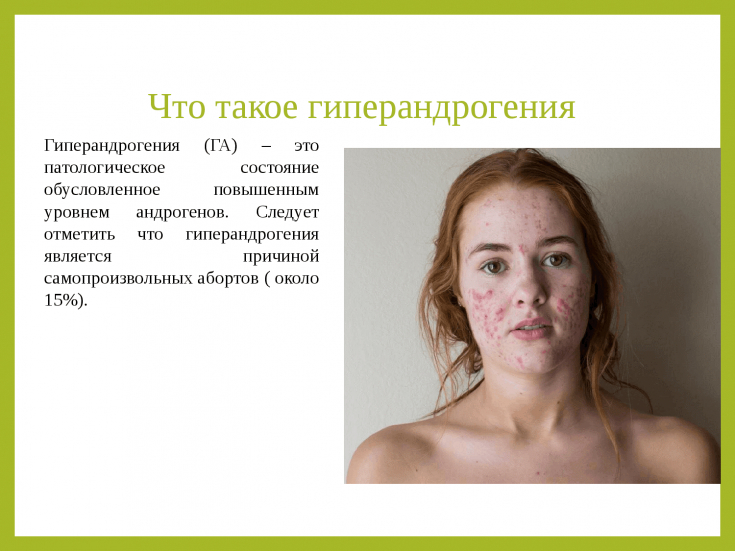Cosmetological problems caused by manifestations of hyperandrogenism: acne, hirsutism, seborrhea, brittle hair, alopecia, ─ are an actual problem of modern dermatology and gynecology. To select adequate therapy in this cohort of women, it is important for the doctor to understand the complex pathogenetic relationships of the mechanisms and causes of the development of skin changes in this pathology.
Find out in the article on estet-portal.com what signs on the skin are accompanied by hyperandrogenism syndrome, as well as the mechanism of their occurrence.
- cutaneous manifestations of hyperandrogenism syndrome
- skin diseases in hyperandrogenism syndrome at a young age
- seborrhea and acne in hyperandrogenism syndrome
Skin manifestations of hyperandrogenism syndrome
Androgen receptors are present in various tissues and organs of the body, including the skin and hypodermis.
Subscribe to our page on Facebook!
That is why, in addition to the characteristic virilization and reproductive dysfunction, hyperandrogenism is also manifested by certain dermatological markers, such as:
- seborrhea and seborrheic dermatitis
- acne
- hirsutism
- androgenetic alopecia
The impact of external factors and hormones on the condition and processes of skin aging
The manifestations of hyperandrogenism syndrome also include black acanthosis (Acanthosis nigricans). However, it should be said that only benign (juvenile) form of black acanthosis associated with hyperandrogenism; the presence of other forms indicates the possibility of the existence of malignant neoplasms of internal organs.
Skin diseases associated with hyperandrogenism syndrome at a young age
The well-known formula of youth: radiance, nutrition and biorevitalization
In a cohort of people of adolescence and young age, the frequency of acne is significantly higher than the average, reaching 80-90%; while clinically significant forms account for 15%. Clinical signs of acne, as a manifestation of hyperandrogenism, most often begin to appear at the age of 12-14 years, and the peak incidence in women occurs at the age of 14-17 years, after which regression occurs; but nearly 20% of adolescents develop acne very slowly.
At the same time, the problem of acne and its cosmetic consequences is also of concern to older people.
After 25 years, acne occurs in 11% of individuals, in the future, the prevalence of this pathology decreases to 3-8%. Unlike young women, older people often experience acne on the background of dry skin. These clinical age-related features require different approaches to both topical acne therapy and their systemic treatment.

Consequently, to determine the most optimal approaches to the correction of acne and seborrhea in women it is necessary to distinguish between the pathogenetic mechanisms of their occurrence in people of different ages.
Seborrhea and acne in hyperandrogenism syndrome
Seborrhea and acne share a common pathogenesis. Undoubtedly, certain genetic factors play an important role in their occurrence. Although acne is not a hereditary disease, however, there are certain gene variations that determine the development of the sebaceous glands and their functional ability. This factor often determines the severity of clinical manifestations of both seborrhea and acne.

When the receptor apparatus of the skin is disturbed and the concentration of sex hormones increases, one can observe a vivid picture of acne and seborrhea, which can often be resistant to local therapy. Given the above mechanisms of the pathogenesis of seborrhea and acne, it can be concluded that it is necessary to prescribe combined oral contraceptives with an antiandrogenic effect in order to treat this dermatological pathology.
Injection correction of the lower jaw line: important aspects
Of course, mild manifestations of seborrhea and acne in hyperandrogenism syndrome require only cosmetic correction. However, moderate and severe forms of acne against the background of hyperandrogenism are indications for the use of oral contraception in women, today it is justified for the treatment of seborrhea and acne.
Late allergic reactions to hyaluronic acid fillers
When choosing the optimal combined oral contraceptive, each link in the development of seborrhea and acne should be taken into account:because the choice of an oral contraceptive with antiandrogenic action, but without affecting the enzyme systems and globulins that bind sex hormones, may be ineffective in reducing manifestations of acne and seborrhea.
Subscribe to our YouTube-channel!









Add a comment